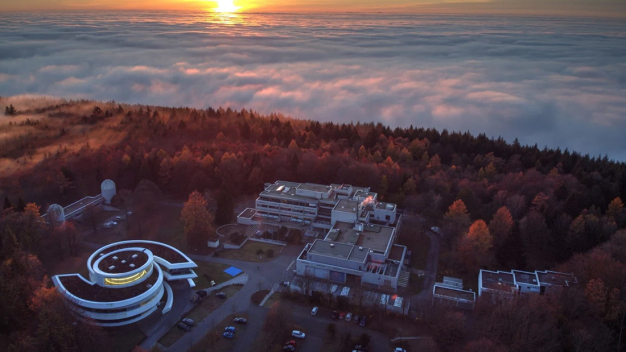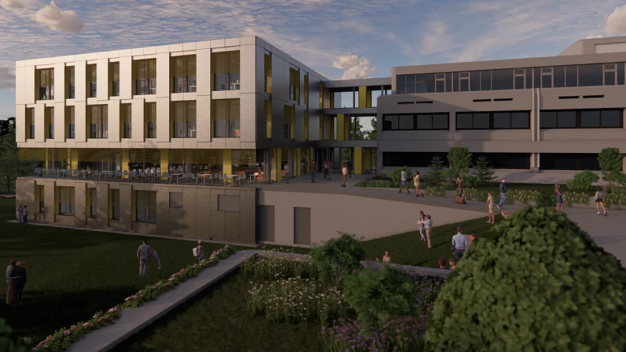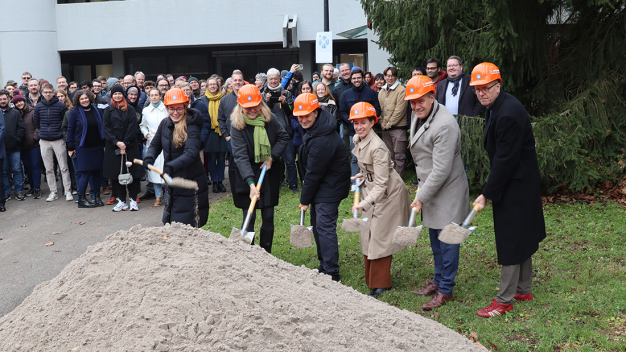- New building
Ground-breaking ceremony for extension building at the Max Planck Institute for Astronomy
Construction work on a new, state-of-the-art extension building for the Max Planck Institute for Astronomy (MPIA) began on November 13, 2024, with a ground-breaking ceremony attended by prominent guests such as Heidelberg's Lord Mayor Eckart Würzner. Over the next two years, the world-renowned research institute on Heidelberg's Königstuhl will not only receive additional office space and laboratories, but also a new canteen area.
For over 50 years, MPIA has been one of the leading international institutes in the field of modern astrophysics. It is not only known for its outstanding research. The institute is also an international address when it comes to the development and construction of high-tech measuring instruments for the world's largest ground-based and space-based telescopes. Recently, for example, the MPIA has made important contributions to the famous James Webb Space Telescope (JWST) and the Extremely Large Telescope (ELT) in Chile, the largest telescope in the world, which is currently under construction.
Research at MPIA is conducted in three departments under the leadership of three directors. Laura Kreidberg heads the Department of Atmospheric Physics of Exoplanets (APEx), Hans-Walter Rix the Department of Galaxies and Cosmology (GC), and Myriam Benisty the Department of Planet and Star Formation (PSF). Ms. Benisty only took over this department in 2024 from retiring Director Thomas Henning, who will remain active at the institute as Director Emeritus.
Over the last two decades, the number of people working at MPIA has more than doubled to well over 300. Particularly since the launch of an additional, third department in 2020 to research the atmospheres of exoplanets under the leadership of the current Managing Director Laura Kreidberg, plans for an extension to the institute's campus have matured. The existing main building and the Elsässer Laboratory (an observatory building named after the founding director) are currently located on the 54,000 m² site, as has the House of Astronomy since 2011.
"We in Heidelberg are very proud of the international reputation of our numerous leading scientific institutions. The MPIA on the Königstuhl has been one of these for more than half a century and has continued to grow in importance over this time. I am therefore particularly pleased that the Max Planck Society is laying an important foundation for continuing the MPIA's success story into the new millennium with the new extension building," says Heidelberg's Lord Mayor Eckart Würzner.
The new, separate building with four levels is an extension to the south end of the existing main building and will be connected to it on all levels by approx. 7m long glazed walkways. The extension, with its 600 m², will preserve the existing green space in front of the Elsässer Laboratory as far as possible. The extension therefore offers a large gain in space with a small footprint.
"We would like to thank the Max Planck Society and the architects for making the extension a reality. The new extension will have everything that is necessary for modern research work. In addition to offices for 46 new workplaces, there will also be seminar and meeting rooms. Furthermore, there will also be laboratories with a focus on optics and spectroscopy, including clean room qualities, technical rooms, service areas for IT and a server room. All of this is crucial for successful work at an international level," says Laura Kreidberg, Managing Director of the MPIA.
"The almost cube-shaped structure with an inner courtyard on the upper levels enables the spatial proximity to each other that is necessary to promote informal communication between everyone in the best possible way. The individual working places are oriented towards the outside with a quiet, wide view of the clearing and the forest for good concentration. In the center, the open, shared work and communication areas with kitchenettes, which support the typical scientific teamwork with intensive communication among each other, are located around the inner courtyard. This provides a bright, pleasant atmosphere with plenty of daylight. The building incision forms a covered terrace for the casino, which can be seen from afar from the center of the clearing and from which you can see the entire clearing," says Michael Wilkens of kreuger wilkins architekten.
The new building also scores highly in terms of sustainability: A photovoltaic system will be installed on the green roof; in addition, building materials will be left as raw as possible without further treatment, such as the façade cladding made of galvanized sheet steel.
Anyone entering the extension building via the barrier-free entrance in future will also find another key element of the new building: a new canteen with a kitchen and dining room for the entire institute. This is because the current canteen facilities at the MPIA are historically only designed for 64 people and, despite time-consuming shift work, many employees currently have to eat their meals in offices or meeting rooms. In future, 120 people will be able to eat at the same time in a modern and contemporary ambience on 180 m² and, thanks to the special room acoustics and technical equipment, part of the dining room can also be used as a seminar room for special occasions.
The architectural office kreuger wilkins architekten is responsible for the architecture and construction supervision of the building. The Max Planck Society is the client for the extension, which has a net cost volume of around 12.6 million euros.
Max-Planck-Institut für Astronomie, Heidelberg
69117 Heidelberg
Germany











